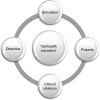Telehealth and eHealth in nurse practitioner training: current perspectives
- PMID: 28721113
- PMCID: PMC5498674
- DOI: 10.2147/AMEP.S116071
Telehealth and eHealth in nurse practitioner training: current perspectives
Abstract
Telehealth is becoming a vital process for providing access to cost-effective quality care to patients at a distance. As such, it is important for nurse practitioners, often the primary providers for rural and disadvantaged populations, to develop the knowledge, skills, and attitudes needed to utilize telehealth technologies in practice. In reviewing the literature, very little information was found on programs that addressed nurse practitioner training in telehealth. This article provides an overview of both the topics and the techniques that have been utilized for training nurse practitioners and nurse practitioner students in the delivery of care utilizing telehealth. Specifically, this article focuses on topics including 1) defining telehealth, 2) telehealth etiquette, 3) interprofessional collaboration, 4) regulations, 5) reimbursement, 6) security/Health Insurance Portability and Accountability Act (HIPAA), 7) ethical practice in telehealth, and 8) satisfaction of patients and providers. A multimodal approach based on a review of the literature is presented for providing the training: 1) didactics, 2) simulations including standardized patient encounters, 3) practice immersions, and 4) telehealth projects. Studies found that training using the multimodal approach allowed the students to develop comfort, knowledge, and skills needed to embrace the utilization of telehealth in health care.
Keywords: health care; nurse practitioner education; simulation; telehealth; telemedicine.
Conflict of interest statement
Disclosure The authors report no conflicts of interest in this work.
Figures



References
-
- Gardenier D, Rutledge CM, Gray D. Are nurse practitioners ready for telehealth? J Nurs Pract. 2015;11(9):860–861.
-
- Totten A, Womak D, Eden K, et al. Telehealth: mapping the evidence for patient outcomes from systematic reviews. Agency Healthc Res Qual. 2016 Jun; Report no 16-EHC034-EF. - PubMed
-
- Ishibashi Y, Jzoji H, Kitano T, Nakajima I. ITU e-Health training program for pacific island community with the support of the Saskawa Peace Foundation. J Med Syst. 2011;35(3):345–351. - PubMed
Publication types
LinkOut - more resources
Full Text Sources
Other Literature Sources
Medical
Research Materials

